Today I had the pleasure of co-teaching a class of 1st graders. Being only the second week of the school year, I was amazed at how deftly the teacher peppered her math lesson with mini-lessons on the various routines and protocols of the classroom. This old former-math-teacher-turned-elementary-coach learned tons about how to run a 1st grade class. Humbling, truly humbling.
I was able to return the favor by sharing some math thoughts. Here is how our time progressed and my resulting mathematical thoughts.
The teacher began by posting two fish bowls on the board and used chips to represent goldfish. She put seven “fish” in one fishbowl and two in the other.
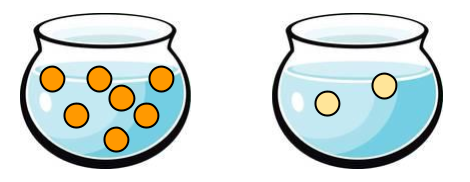
Teacher: “How many fish are in the left fishbowl?”
Class: “7!!”
T: “How many in the bowl on the right?”
C: “2!!”
T: “How can we use those two numbers to begin filling in this number bond?” (She posts a laminated number bond on the board.)
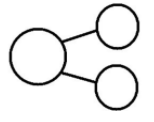
C: “Write a 7 in the top circle and a 2 in the bottom circle!” (The teacher does so.)
T: “What number should I put here?” (The teacher points at the big empty circle.)
Here is where the cool thing happens…
Some students began pointing at the chips one-by-one, clearly counting. Other students simply raised their hands.
T: “At the snap of my finger, say the answer.” (She snaps.)
C: “Niiiiiine!”
T: “How many fish are there in all?”
C: “Nine”
T: “7 plus 2 equals….” (She writes ‘7 + 2 =’ on the board.)
C: “Nine”
So what was the cool thing?
All the students got the right answer, and yet it was obvious that the students were in a variety of developmental stages of counting.
There are three stages of counting:
- Stage 1: Count all
- Stage 2: Count on
- Stage 3: Make an easier problem (Use a strategy)
Stage 1: Count all
When given a group of 7 chips and a group of 2 chips and asked “How many are there?”, students in this stage count all 9 chips one-by-one. Students in this stage recognize the need for one-to-one correspondence as they count the chips. This is typical for students in Kindergarten.
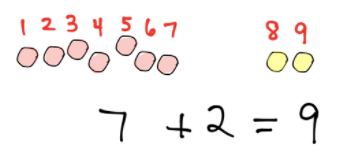
Stage 2: Count on
At this stage, students are able to see one group as an entity (recognizing the cardinality of the group) and count on from there, often touching each chip of the second group as they count. In 7+2, a student might say “Seeeeven, eight, nine” as he touches each of the two chips in the second bowl. Stage 2 is typically introduced in Grade 1 (although some Kinders may begin Stage 2) with the hope that all 1st graders will have this stage under their belt by the end of the year.
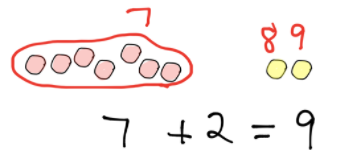
Stage 3: Make an easier problem (Use a strategy)
This stage is introduced in Grade 1 with the hopes that students will internalize this strategy later in Grade 1 or in Grade 2. This stage is easier to describe with a problem such as 8 + 5. A student in Stage 3 might take two from the five and give it to the eight, making 10. Then add 10 and the remaining 3 to get 13.
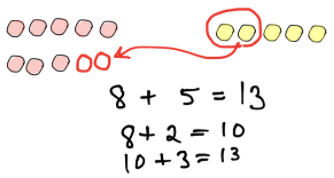
For a problem an addition problem within 10, students in Stage 3 might explain knowing 7+2=9 by saying something like “I just knew it in my head”.
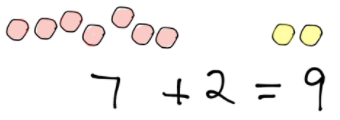
Why do we need to know the three stages of counting?
It is not enough to see that a student has written “7 + 2 = 9” beneath the fish bowl on her paper. We teachers need to dig a bit deeper and determine with which stage did the student use to get that answer? A student who gets 100% on her paper is not considered fluent with basic facts if she uses “Stage 1 Count All” on every problem.
 Basic fact fluency requires the presence of flexibility, appropriate strategy use, efficiency, and accuracy. It is not enough to verify whether a student can correctly solve the problems in a timely fashion (ala “timed tests”…but that is a different blog post…ugh). Somehow, the teacher needs to also assess the flexibility and strategy use of each student. This is where number talks, small groups, and informal formative assessment comes in. Somehow for each student the teacher must identify the student’s current developmental stage (count all, count on, or make an easier problem) and then nudge that child to the next level up.
Basic fact fluency requires the presence of flexibility, appropriate strategy use, efficiency, and accuracy. It is not enough to verify whether a student can correctly solve the problems in a timely fashion (ala “timed tests”…but that is a different blog post…ugh). Somehow, the teacher needs to also assess the flexibility and strategy use of each student. This is where number talks, small groups, and informal formative assessment comes in. Somehow for each student the teacher must identify the student’s current developmental stage (count all, count on, or make an easier problem) and then nudge that child to the next level up.
It was fascinating to watch the three stages in action during this single 1st grade lesson. It is humbling to me to advise the teacher how to determine the stage of each child. I take comfort in the fact that if I was the teacher I wouldn’t worry about trying to assess the stage of EVERY student in a single day. Perhaps I’d use an anecdotal list to record the stages of the various students I happen to come across. Then specifically target the remaining students during centers time.
My challenge to us all
When we wander around the room, looking over the shoulders of our kiddos at their answers, let’s try to go one step beyond merely checking if the answers are correct. Take a moment with one or two students per day to focus not only on WHAT is the student’s answer, but also HOW did the student arrive at that answer?
Oh yeah…while ensuring proper classroom control with the other 24 students. But THAT is for another blog post.
